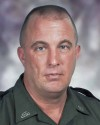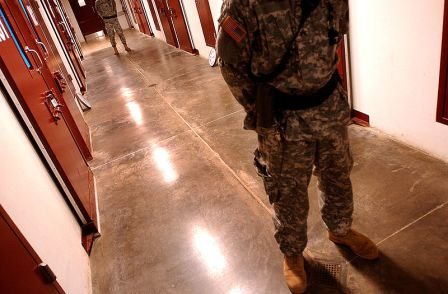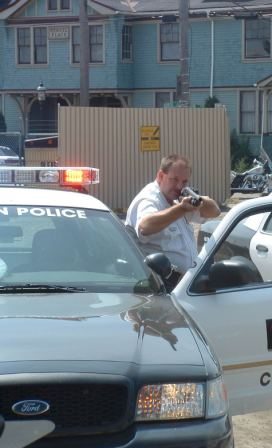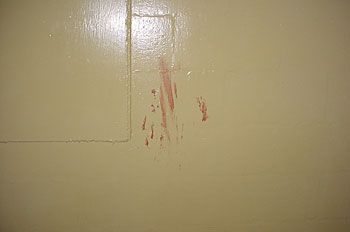Trooper Ketchem Kwik turned toward his partner, Frank Lee I dunno. “There’s got to be something we can charge this clown with. How about Ugly in Public?”
“Be serious, Kwik. We don’t come up with something legit soon, we’re gonna hafta cut him loose. So keep digging.”
Kwik turned another page in his well-worn copy of the Code of Virginia. “This stuff all sounds like gobbledygook to me. Like this…what the heck does adulterate mean? Why don’t they just write it in plain ol’ Engl…wait a minute…yep…here we go.” Kwik jabbed an index finger against a spot midway on the page. “Yep, I think I’ve got something. Our guy is a sure enough, for real a…dult…er…ator. Says so right here. And it’s a felony, too.”
IDunno leaned over Kwik’s shoulder to get a better look.
§ 18.2-54.2. Adulteration of food, drink, drugs, cosmetics, etc.; penalty.
Any person who adulterates or causes to be adulterated any food, drink, prescription or over-the-counter medicine, cosmetic or other substance with the intent to kill or injure any individual who ingests, inhales or uses such substance shall be guilty of a Class 3 felony.
“Good job, Kwik. Let’s go give the prick the good news. I’m sure he’ll be real happy in the sheriff’s concrete hotel. And, I think he’ll look really sweet in orange.”
The two officers headed down the hallway, passing Booking and the LiveScan terminal, along the way toward the central holding cells.
“A…dul…ter…a…tion…,” Kwik mumbled. “Still sounds like a sex crime to me. Go figure.”

Trooper Kwik’s dilemma is a little far-fetched, but real-life officers and investigators often turn to the law books for guidance when determining proper charges. To give you an idea of how this all plays out in writing, here are a few code sections used by law enforcement in the Commonwealth of Virginia.
Code of Virginia section 18.2 is where criminal codes can be found. For example:
§ 18.2-32. First and second degree murder defined; punishment.
Murder, other than capital murder, by poison, lying in wait, imprisonment, starving, or by any willful, deliberate, and premeditated killing, or in the commission of, or attempt to commit, arson, rape, forcible sodomy, inanimate or animate object sexual penetration, robbery, burglary or abduction, except as provided in § 18.2-31, is murder of the first degree, punishable as a Class 2 felony.
All murder other than capital murder and murder in the first degree is murder of the second degree and is punishable by confinement in a state correctional facility for not less than five nor more than forty years.
§ 18.2-32.1. Murder of a pregnant woman; penalty.
The willful and deliberate killing of a pregnant woman without premeditation by one who knows that the woman is pregnant and has the intent to cause the involuntary termination of the woman’s pregnancy without a live birth shall be punished by a term of imprisonment of not less than ten years nor more than forty years.
§ 18.2-33. Felony homicide defined; punishment.
The killing of one accidentally, contrary to the intention of the parties, while in the prosecution of some felonious act other than those specified in §§ 18.2-31 and 18.2-32, is murder of the second degree and is punishable by confinement in a state correctional facility for not less than five years nor more than forty years.
§ 18.2-40. Lynching deemed murder.
Every lynching shall be deemed murder. Any and every person composing a mob and any and every accessory thereto, by which any person is lynched, shall be guilty of murder, and upon conviction, shall be punished as provided in Article 1 (§ 18.2-30 et seq.) of this chapter.
Lynching is defined as – Any act of violence by a mob upon the body of any person, which shall result in the death of such person, shall constitute a “lynching.”
§ 18.2-46.2. Prohibited criminal street gang participation; penalty.
A. Any person who actively participates in or is a member of a criminal street gang and who knowingly and willfully participates in any predicate criminal act committed for the benefit of, at the direction of, or in association with any criminal street gang shall be guilty of a Class 5 felony. However, if such participant in or member of a criminal street gang is age eighteen years or older and knows or has reason to know that such criminal street gang also includes a juvenile member or participant, he shall be guilty of a Class 4 felony.
§ 18.2-46.7. Act of bioterrorism against agricultural crops or animals; penalty.
Any person who maliciously destroys or devastates agricultural crops or agricultural animals having a value of $2,500 or more through the use of an infectious biological substance with the intent to (i) intimidate the civilian population or (ii) influence the conduct or activities of the government of the United States, a state or locality through intimidation, is guilty of a Class 3 felony.
For the purposes of this section “agricultural animal” means all livestock and poultry as defined in § 3.2-5900 and “agricultural crop” means cultivated plants or produce, including grain, silage, forages, oilseeds, vegetables, fruits, nursery stock or turf grass.
§ 18.2-47. Abduction and kidnapping defined; punishment.
A. Any person who, by force, intimidation or deception, and without legal justification or excuse, seizes, takes, transports, detains or secretes another person with the intent to deprive such other person of his personal liberty or to withhold or conceal him from any person, authority or institution lawfully entitled to his charge, shall be deemed guilty of “abduction.”
B. Any person who, by force, intimidation or deception, and without legal justification or excuse, seizes, takes, transports, detains or secretes another person with the intent to subject him to forced labor or services shall be deemed guilty of “abduction.” For purposes of this subsection, the term “intimidation” shall include destroying, concealing, confiscating, withholding, or threatening to withhold a passport, immigration document, or other governmental identification or threatening to report another as being illegally present in the United States.
C. The provisions of this section shall not apply to any law-enforcement officer in the performance of his duty. The terms “abduction” and “kidnapping” shall be synonymous in this Code. Abduction for which no punishment is otherwise prescribed shall be punished as a Class 5 felony.
D. If an offense under subsection A is committed by the parent of the person abducted and punishable as contempt of court in any proceeding then pending, the offense shall be a Class 1 misdemeanor in addition to being punishable as contempt of court. However, such offense, if committed by the parent of the person abducted and punishable as contempt of court in any proceeding then pending and the person abducted is removed from the Commonwealth by the abducting parent, shall be a Class 6 felony in addition to being punishable as contempt of court.
§ 18.2-54.1. Attempts to poison.
If any person administers or attempts to administer any poison or destructive substance in food, drink, prescription or over-the-counter medicine, or otherwise, or poisons any spring, well, waterworks as defined in § 32.1-167, or reservoir of water with intent to kill or injure another person, he shall be guilty of a Class 3 felony.
§ 18.2-56.2. Allowing access to firearms by children; penalty.
A. It shall be unlawful for any person to recklessly leave a loaded, unsecured firearm in such a manner as to endanger the life or limb of any child under the age of fourteen. Any person violating the provisions of this subsection shall be guilty of a Class 3 misdemeanor.
B. It shall be unlawful for any person knowingly to authorize a child under the age of twelve to use a firearm except when the child is under the supervision of an adult. Any person violating this subsection shall be guilty of a Class 1 misdemeanor. For purposes of this subsection, “adult” shall mean a parent, guardian, person standing in loco parentis to the child or a person twenty-one years or over who has the permission of the parent, guardian, or person standing in loco parentis to supervise the child in the use of a firearm.
§ 18.2-57.01. Pointing laser at law-enforcement officer unlawful; penalty.
If any person, knowing or having reason to know another person is a law-enforcement officer as defined in § 18.2-57, a probation or parole officer appointed pursuant to § 53.1-143, a correctional officer as defined in § 53.1-1, or a person employed by the Department of Corrections directly involved in the care, treatment or supervision of inmates in the custody of the Department engaged in the performance of his public duties as such, intentionally projects at such other person a beam or a point of light from a laser, a laser gun sight, or any device that simulates a laser, shall be guilty of a Class 2 misdemeanor.
§ 18.2-61. Rape.
A. If any person has sexual intercourse with a complaining witness, whether or not his or her spouse, or causes a complaining witness, whether or not his or her spouse, to engage in sexual intercourse with any other person and such act is accomplished (i) against the complaining witness’s will, by force, threat or intimidation of or against the complaining witness or another person; or (ii) through the use of the complaining witness’s mental incapacity or physical helplessness; or (iii) with a child under age 13 as the victim, he or she shall be guilty of rape.
B. A violation of this section shall be punishable, in the discretion of the court or jury, by confinement in a state correctional facility for life or for any term not less than five years; and in addition:
1. For a violation of clause (iii) of subsection A where the offender is more than three years older than the victim, if done in the commission of, or as part of the same course of conduct as, or as part of a common scheme or plan as a violation of (i) subsection A of § 18.2-47 or § 18.2-48, (ii) § 18.2-89, 18.2-90, or 18.2-91, or (iii) § 18.2-51.2, the punishment shall include a mandatory minimum term of confinement of 25 years; or
2. For a violation of clause (iii) of subsection A where it is alleged in the indictment that the offender was 18 years of age or older at the time of the offense, the punishment shall include a mandatory minimum term of confinement for life.
If the term of confinement imposed for any violation of clause (iii) of subsection A, where the offender is more than three years older than the victim, is for a term less than life imprisonment, the judge shall impose, in addition to any active sentence, a suspended sentence of no less than 40 years. This suspended sentence shall be suspended for the remainder of the defendant’s life, subject to revocation by the court.
There shall be a rebuttable presumption that a juvenile over the age of 10 but less than 12, does not possess the physical capacity to commit a violation of this section. In any case deemed appropriate by the court, all or part of any sentence imposed for a violation under this section against a spouse may be suspended upon the defendant’s completion of counseling or therapy, if not already provided, in the manner prescribed under § 19.2-218.1 if, after consideration of the views of the complaining witness and such other evidence as may be relevant, the court finds such action will promote maintenance of the family unit and will be in the best interest of the complaining witness.
C. Upon a finding of guilt under this section, when a spouse is the complaining witness in any case tried by the court without a jury, the court, without entering a judgment of guilt, upon motion of the defendant who has not previously had a proceeding against him for violation of this section dismissed pursuant to this subsection and with the consent of the complaining witness and the attorney for the Commonwealth, may defer further proceedings and place the defendant on probation pending completion of counseling or therapy, if not already provided, in the manner prescribed under § 19.2-218.1. If the defendant fails to so complete such counseling or therapy, the court may make final disposition of the case and proceed as otherwise provided. If such counseling is completed as prescribed under § 19.2-218.1, the court may discharge the defendant and dismiss the proceedings against him if, after consideration of the views of the complaining witness and such other evidence as may be relevant, the court finds such action will promote maintenance of the family unit and be in the best interest of the complaining witness.
§ 18.2-10. Punishment for conviction of felony; penalty.
The authorized punishments for conviction of a felony are:
(a) For Class 1 felonies, death, if the person so convicted was 18 years of age or older at the time of the offense and is not determined to be mentally retarded pursuant to § 19.2-264.3:1.1, or imprisonment for life and, subject to subdivision (g), a fine of not more than $100,000. If the person was under 18 years of age at the time of the offense or is determined to be mentally retarded pursuant to § 19.2-264.3:1.1, the punishment shall be imprisonment for life and, subject to subdivision (g), a fine of not more than $100,000.
(b) For Class 2 felonies, imprisonment for life or for any term not less than 20 years and, subject to subdivision (g), a fine of not more than $100,000.
(c) For Class 3 felonies, a term of imprisonment of not less than five years nor more than 20 years and, subject to subdivision (g), a fine of not more than $100,000.
(d) For Class 4 felonies, a term of imprisonment of not less than two years nor more than 10 years and, subject to subdivision (g), a fine of not more than $100,000.
(e) For Class 5 felonies, a term of imprisonment of not less than one year nor more than 10 years, or in the discretion of the jury or the court trying the case without a jury, confinement in jail for not more than 12 months and a fine of not more than $2,500, either or both.
(f) For Class 6 felonies, a term of imprisonment of not less than one year nor more than five years, or in the discretion of the jury or the court trying the case without a jury, confinement in jail for not more than 12 months and a fine of not more than $2,500, either or both.
§ 18.2-11. Punishment for conviction of misdemeanor.
The authorized punishments for conviction of a misdemeanor are:
(a) For Class 1 misdemeanors, confinement in jail for not more than twelve months and a fine of not more than $2,500, either or both.
(b) For Class 2 misdemeanors, confinement in jail for not more than six months and a fine of not more than $1,000, either or both.
(c) For Class 3 misdemeanors, a fine of not more than $500.
(d) For Class 4 misdemeanors, a fine of not more than $250.
*Note that felony convictions result in prison sentences. Misdemeanors = time in jail. Prison and jail are NOT the same.
*Laws vary from state to state.






































